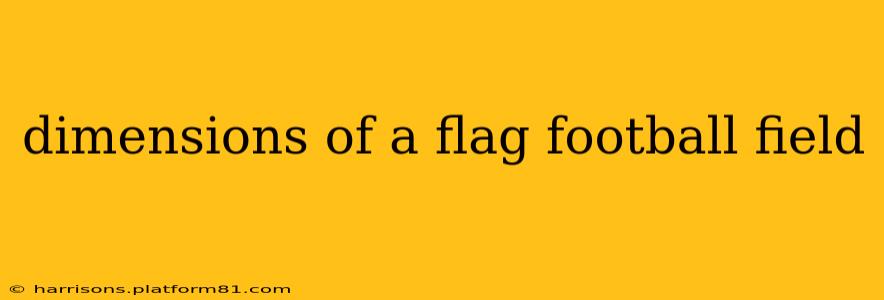Flag football, a popular variation of American football, is enjoyed by people of all ages and skill levels. Understanding the dimensions of a flag football field is crucial for players, coaches, and referees alike. While there isn't a single universally standardized size, typical dimensions and variations exist depending on the league, age group, and playing level. This guide will clarify the common dimensions and address frequently asked questions.
What are the standard dimensions of a flag football field?
The dimensions of a flag football field are generally smaller than those of a standard American football field. A typical flag football field measures between 20 and 80 yards long and between 15 and 60 yards wide. However, this is quite a broad range; it's more useful to consider the dimensions according to the age and skill level of the players. Youth leagues often use significantly smaller fields, while adult leagues may opt for dimensions closer to a regulation American football field. Many leagues opt for a field of approximately 50 yards in length and 25 yards in width as a good compromise between playability and space requirements.
How does the field size vary for different age groups?
The size of the flag football field is directly related to the age and abilities of the players. Younger children play on smaller fields to ensure the game remains manageable and fun. As players age and their skills develop, the field size typically increases to allow for more strategic play and to accommodate increased running distances. Here's a general guideline:
- Youth Leagues (6-10 years old): Often use significantly smaller fields, sometimes as small as 20 yards by 15 yards.
- Teen Leagues (11-17 years old): Fields generally increase in size, ranging from 40 to 50 yards in length and 20 to 30 yards in width.
- Adult Leagues: May utilize fields ranging from 50 to 80 yards in length and 25 to 60 yards in width, sometimes even closer to a regulation football field.
Are there specific markings on a flag football field?
While the specific markings can vary, most flag football fields incorporate some common elements:
- End Zones: These are rectangular areas at each end of the field, typically extending 5-10 yards into the field. A touchdown is scored when a player enters the opposing team's end zone with the flag.
- Yard Lines: Similar to a standard American football field, yard lines may be marked every 5 or 10 yards to track downfield progress. However, this is less common than the end zones.
- Sidelines: These mark the boundaries of the playing field, typically marked with cones or other temporary field markers.
What are the dimensions of the end zones in flag football?
The dimensions of the end zones are not rigidly standardized but generally range from 5 to 10 yards deep. This depth depends largely on the overall size of the field; larger fields tend to have slightly deeper end zones. The width of the end zone mirrors the width of the playing field.
How do I determine the appropriate field size for my flag football game?
The best field size depends heavily on the players' ages, skills, and the overall game objectives. Consider the following factors:
- Age and physical capabilities of the players: Younger and less physically developed players benefit from smaller fields.
- Number of players: More players may require a slightly larger field to avoid overcrowding.
- Available space: The available space will naturally dictate the maximum field size.
- League rules and regulations: Some leagues may specify official field dimensions.
Always prioritize safety and enjoyable gameplay when choosing your field dimensions.
What equipment is needed to mark a flag football field?
Marking a flag football field typically requires simple, readily available equipment:
- Measuring Tape: To accurately determine the desired field dimensions.
- Marking Cones or Flags: To delineate the sidelines, end zones, and yard lines (if used).
- Spray Paint (optional): For more permanent field markings (though not recommended for temporary use).
By understanding these dimensions and guidelines, you can ensure a safe, fair, and enjoyable game of flag football for all participants. Remember to always prioritize safety and adapt the field size to the abilities and ages of the players involved.
